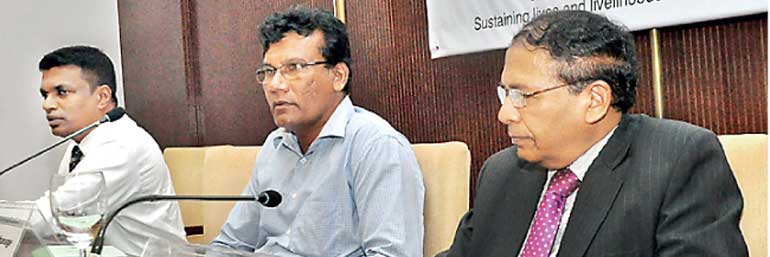Thursday Apr 25, 2024
Thursday Apr 25, 2024
Tuesday, 19 January 2016 00:39 - - {{hitsCtrl.values.hits}}
Sri Lanka is a signatory to the United Nations Framework Convention on Climate Change (UNFCCC) since 1992. The UN-REDD Program is the United Nations Collaborative Initiative on Reducing Emissions from Deforestation and forest Degradation (UN-REDD) in developing countries. REDD+ identifies five major activities for which results-based payments may be claimed:
In line with the conclusion of the climate change summit in Paris last December (COP21), the Government of Sri Lanka has reinforced its commitment to develop a national REDD+ strategy as a vital part of its contribution to combat climate change. The Forest Department is moving forward together with the Department of Wildlife Conservation and the Climate Change Secretariat with the blessing of President Maithripala Sirisena to increase forest cover from 29.7% to 32%.
 From left: UN REDD Programme National Project Director Anura Sathurusinghe, Center for Environmental Justice Executive Director Hemantha Withanage and Ministry of Mahaweli Development and Enviroment Advisor Prof L. Sumathipala - Pic by Shehan Gunasekara
From left: UN REDD Programme National Project Director Anura Sathurusinghe, Center for Environmental Justice Executive Director Hemantha Withanage and Ministry of Mahaweli Development and Enviroment Advisor Prof L. Sumathipala - Pic by Shehan Gunasekara
The final draft of the Paris Agreement on Climate Change directly addresses the crucial role of the world’s forests – together with carbon emission cuts – in efforts aimed at mitigating rising global temperatures. The catastrophic impact of climate change is already being seen across the world and most countries have woken up to the urgent need to arrest rising global temperatures. The Agriculture, Forestry and Other Land Use (AFOLU) sector is responsible for just under a quarter of anthropogenic greenhouse gas (GHG) emissions while forestry alone account for nearly 12%.
The Government of Sri Lanka along with other stakeholders including civil society organisations, indigenous people, academics, forest dependent communities and the private sector partners are jointly preparing for a comprehensive national REDD+ strategy that considers all aspects of forestry and beyond. This strategy is aimed at conserving Sri Lanka’s rich biodiversity and natural resources, when addressing the issue of deforestation and forest degradation.
“At present we are at the ‘Readiness Phase’ where we set the ground work for the REDD+ program by developing the National REDD+ Strategy with the participation of all stakeholders. Sri Lanka’s forests are under threat because of many factors, so the National REDD+ Strategy that is being developed will facilitate the creation of direct and indirect mechanisms to protect our forests. Many of Sri Lanka’s forests are degraded and soil enrichment is required in many areas, while reforestation needs to surpass the level of deforestation.
So there is also potential through REDD+ for the systematic restoration of degraded forests and reforestation of new areas, which will ultimately contribute towards the national drive to increase Sri Lanka’s forest cover,” informs Conservator General of Forests Anura Sathurusinghe.
In 2009, Sri Lanka became a UN-REDD partner country. Since 2013, the Government and participating UN Organisations have been working on the UN-REDD National Program with the ultimate aim of developing a national REDD+ strategy, which would support the Government’s strategy of increasing Sri Lanka’s forest cover.
Explaining the role of the REDD+ program, National Program Manager of the Sri Lanka UN-REDD Program Nalin Munasinghe says: “The vision of the national REDD+ program is to contribute to improving sustainable land management that will conserve biodiversity, maintain economic growth and minimise risks of natural disasters through a step-wise and targeted approach. We are extremely pleased by the encouragement received from the present Government in this area and wish to provide a springboard that will help realise the Government’s and President Maithripala Sirisensa’s environmental agenda.”
The REDD+ program, which has been underway since 2013, has undertaken in-depth studies and analysis of data on the drivers of deforestation and forest degradation. The objective is to prepare a comprehensive strategy by 2017 which will help realise Sri Lanka’s forest conservation goals.
Compared to global forest coverage, Sri Lanka’s forest cover is not significant and historical deforestation rate is low. This implies low potential for emission reductions and removals, and therefore limited prospects for securing REDD+ result-based finance. However the REDD+ strategy would enable Sri Lanka to ensure the protection of the country’s rich bio-diversity, as well as conservation of soil and water catchment areas; non-carbon benefits are the main focus of REDD+ in Sri Lanka.